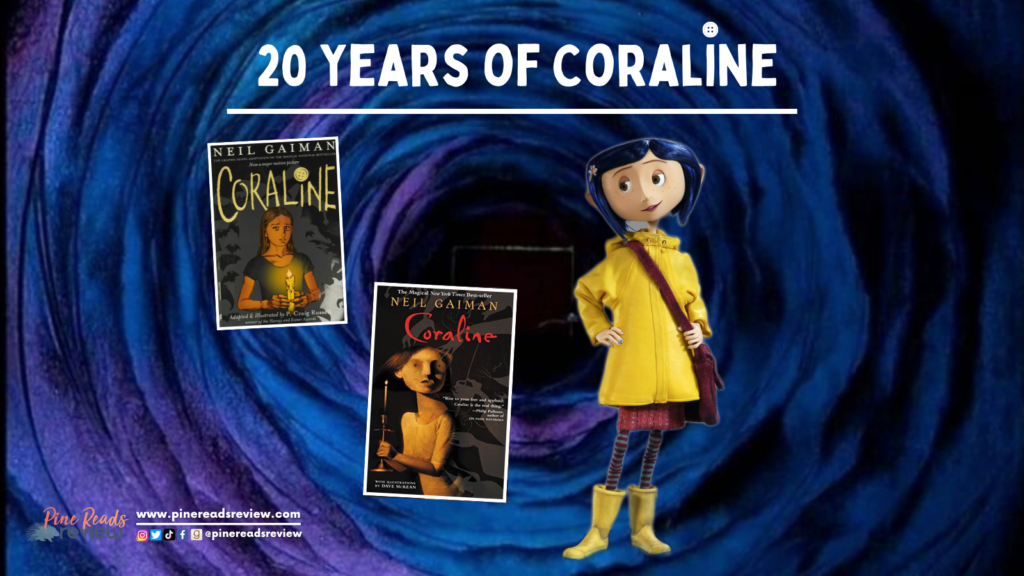
In 1990, author Neil Gaiman began to write a novel about a little girl whose dreams would come true, with a catch. But before delving into this story, he needed a name for his protagonist. While typing out his ideas, he came up with the name Caroline. After reading over his work, though, he discovered a key error that would shape the story we know now. As Gaiman stated, “I had typed the name Caroline, and it came out wrong. I looked at the word Coraline, and knew it was someone’s name.” The book Coraline was published in 2002, and two decades since then, it still resonates with readers and moviegoers alike thanks to a couple of prominent adaptations following the source material. Here we will examine what makes each major adaptation unique and worthy of revisiting for the twenty-year anniversary.
Of course, the first version made was the original novel by Neil Gaiman. In it, Gaiman adapted supernatural elements and tropes into the framework of a children’s book. Functioning much like a bedtime story, the book’s premise warns young readers to stay out of trouble, and more importantly, trust your instincts. This age-old phrase is taken to fictional extremes when Coraline finds herself being lured into a near-perfect version of her own life. Gaiman’s original depiction of Coraline is a polite young British girl who has recently moved to a new home in England. In her new home, there lies an intricately carved wooden door that leads Coraline on an unforeseen adventure. Upon traveling through the door, she meets counterparts of her parents who have buttons for eyes. Both are physically slimmer than her true parents as well as more nurturing. However, they are oddly lifeless in certain scenes. Coraline is immediately suspicious of her newfound second set of parents and leaves their world in favor of her own. Soon after, Coraline is forced to confront her “other mother” who has been pulling the strings behind the ideal world all along. The book’s horror aspects enable Gaiman to convey a strong message to children. No matter how friendly or familiar a stranger’s face may seem, always trust your senses.
Soon after the original book was published in 2002, there was a graphic novel adaptation illustrated by P. Craig Russell in the same year. While this version is obviously a comic, it very closely adheres to the story written by Gaiman. Coraline is similarly thrust into new living conditions and is introduced to a strange parallel world and family. What is unique about this adaptation, however, is the slight shift in theme that comes from the visual component. Coraline’s mixed emotions are explored in the novel, whereas, in the comic, she feels unimpressed because she can differentiate between the real and unreal. The comic instills a sense of maturity in Coraline as she remains mostly calm despite the supernatural elements at play. Her composure is highlighted when she is forced to live alone after her parents go missing, the same as in the novel. She is able to take care of herself for days before realizing that her real parents may not be coming back on their own. Coraline is even seen calling the police in this version before diving headfirst into danger. Following Gaiman’s example, this depiction tells young readers not to confuse all that glitters for gold.
The most well-known version of Coraline is the movie adaptation. The 2008 film made the most changes to the source material, but launched the franchise into pop culture once again. The changes to the story are immediately noticeable as names, locations, and more are altered. Coraline, now a witty American girl with blue hair, moves to Oregon instead of England. Once in her new home, she discovers a boarded-up crawl space instead of a full-size antique door. In the novel, Coraline visits the alternative world twice, but in the film version she goes four times. There is also the addition of a doll crafted by the other mother to resemble and spy on Coraline. Another film addition is the character Wybie, who assists Coraline in defeating the other mother. While the core of the story and events remain the same, the last key difference is the characterization of Coraline herself. Coraline feels neglected by her parents and is therefore enticed by the new life offered by her other mother. While book Coraline never truly embraced the illusion, film Coraline did. Her feeling of neglect in the movie develops into a wish for something more than what her real parents can offer. Again, harkening back to the themes set by Neil Gaiman, the film informs children and adults alike to be careful what you wish for.
No matter how the events of Coraline play out, each new adaptation resonates with young audiences and fans of the spooky genre alike. In the twenty years since the birth of the franchise, every version has collected an award and has amassed a large following. At its center, Coraline is about childhood courage against the unknown. Whether the danger be tempting or just strange, the safest place to be is always beside the ones who truly care. Pick up the version of Coraline nearest to you!
PRR Writer, Vinny Cuadrado
1 thought on “20 Years of Coraline: YA Horror and Beyond”
Comments are closed.